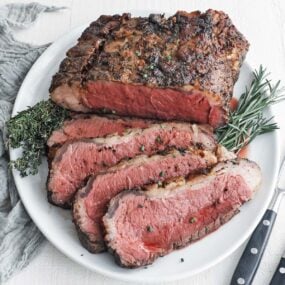

New York Strip Roast
This New York strip roast is dry-brined, reverse-seared, and coated in an incredibly flavorful herb butter for the perfect large gathering entrée. Your friends and family will be blown away by how tender, juicy, and flavorful this roast turns out.
Ingredients
- 8 pound trimmed New York strip roast
- 2 tablespoons coarse salt
- 2 teaspoons ground pepper
- 4 sticks softened unsalted butter
- 1 ½ tablespoons finely minced fresh rosemary
- 1 ½ tablespoons finely minced thyme
- 2 tablespoons finely minced parsley
- 2 tablespoons thinly sliced chives
- 2 finely minced garlic cloves
- zest and juice of 1 lemon, about 2 to 3 tablespoons
- 2 tablespoons dry sherry wine, optional
- 2-4 beef shank bones, optional
- 1 tablespoons olive oil
- coarse salt and freshly cracked pepper to taste
Instructions
- Start by trimming the roast from fat on the top, bottom, and sides. All sinew, silver skin, and stringy-like fat should be removed. However, I do like to keep a ½” fat cap on the top.
- Using your knife, score the fat cap on the top going about an eighth to a max of one-quarter inch deep in both directions.
- Next, truss the beef roast using butcher’s twine.
- Place the roast on a rack over a sheet tray and generously season all sides with coarse salt and ground pepper.
- Put the roast on the rack in the fridge uncovered for 12 to 48 hours.
- Remove the roast from the fridge and let it sit at room temperature for 25-30 minutes to take the chill off it.
- In the meantime, whip the 4 sticks of unsalted butter in a stand mixer with the paddle attachment on high for 5 to 7 minutes or until it becomes light and fluffy.
- Stop the mixer and add the parsley, thyme, rosemary, chives, garlic, lemon zest, juice, salt, pepper, and sherry. Mix on low speed to combine.
- Spread half of the herb butter onto the top of the fat cap of the roast and spread it out using a rubber spatula until it is coated.
- Place a thermometer from the top into the center of the roast and reverse sear it on a middle rack in the oven at 225° until it reaches 108° to 110° internally, which takes about 2 ½ hours.
- Remove the roast, cover it with foil, and let it rest for 60 to 75 minutes.
- While waiting, turn the heat up to 500°. If you have convection, even better.
- You can next optionally coat the beef shank bones in oil, salt, and pepper, and roast on a sheet tray lined with parchment paper and roast in the oven on a middle rack for 20 to 25 minutes or until the marrow is 145° internally.
- Let the bones cool slightly before adding the marrow to a food processor along with the remaining herb butter. Pulse it until it is finely minced and combined with the butter. Set it aside.
- Once the roast is done resting, place it back in the oven on a middle rack at 500° until it reaches 118° to 120° for rare to medium-rare, which takes about 25 minutes.
- Remove the roast and spread on a few tablespoons of the bone marrow butter. Slice and serve.
Notes
To make my New York Strip Roast turn out perfectly juicy and tender, I always account for carryover cooking. I pull the roast 2 to 5 degrees before my target temperature, cover it with foil, and let it rest so the heat gently finishes the cooking.
- Maillard Reaction: When beef is heated to 285°-350°F, the sugar and amino acids react, creating that beautiful brown crust that adds incredible flavor and crispness.
- Reverse Sear Method: I slow-cook the beef at a low temperature, let it rest, and then sear it at high heat for a perfect crust. This method also works great for chicken and pork!
- Cooking Temperatures: For rare, remove the steak from the oven at 115° to 120°; for medium, 125° to 130°; for medium-well, 135° to 140°; and well-done, 140° to 150°.
- Resting & Myoglobin: When the meat rests, the myoglobin, the protein responsible for making meat red, will rush back through the beef. I’m just telling you this because it may take a little while for this to occur. If you slice it and it looks medium to well-done, give it a few seconds, as the red and pink colors will come back through.
- Best Knife Choice: I usually use a boning knife when fabricating any meat.
- Dry Brining for More Flavor: The longer the dry brine, the more flavorful it will become.
- Leftover: There will be leftover bone marrow butter, which you can use in other recipes.
- Resting Between Cooks: When reversing searing meat, a good rule of thumb is to let it rest for half the time as the initial cook. This rest will take place between the first and second cook. There is no need to rest the roast after the second cook.
- Intramuscular Fat (Marbling):Those white streaks of fat running through the beef? That’s marbling, and it’s what makes the meat juicy, tender, and full of flavor.
Nutrition
Calories: 720kcalCarbohydrates: 1gProtein: 63gFat: 50gSaturated Fat: 19gPolyunsaturated Fat: 2gMonounsaturated Fat: 20gTrans Fat: 0.01gCholesterol: 242mgSodium: 1321mgPotassium: 967mgFiber: 0.4gSugar: 0.03gVitamin A: 141IUVitamin C: 3mgCalcium: 81mgIron: 5mg